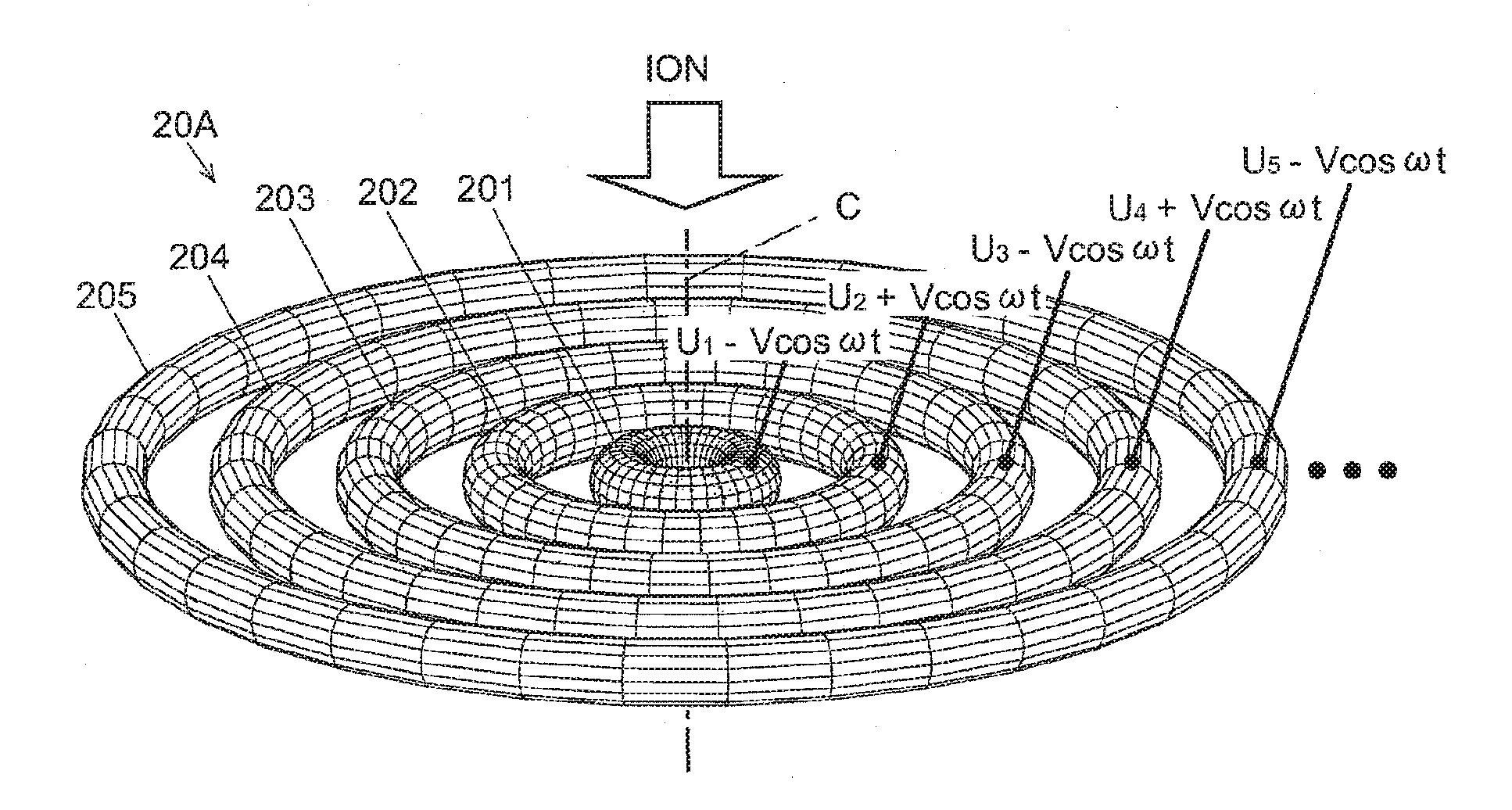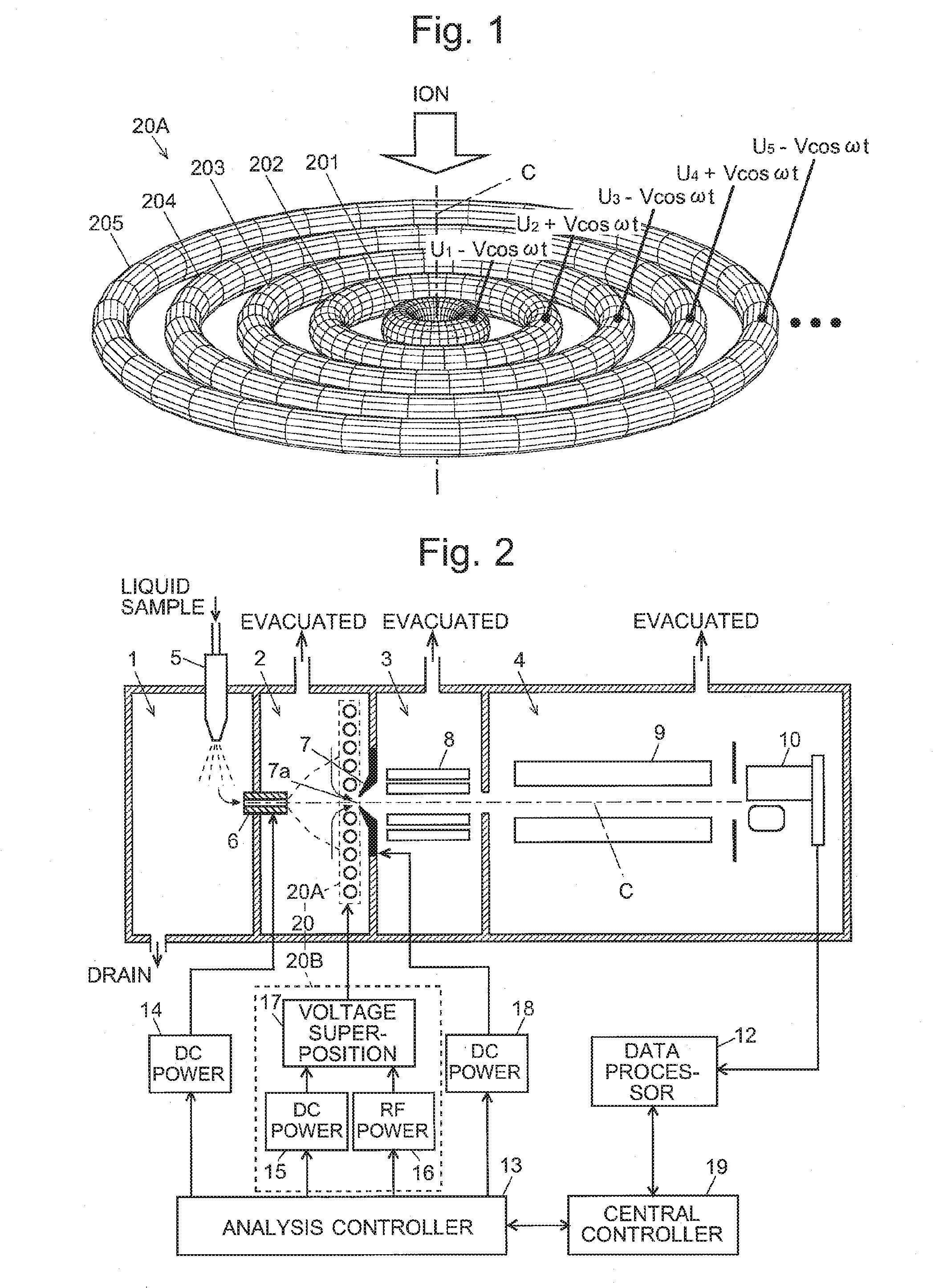Ion transport apparatus and mass spectrometer using the same
a mass spectrometer and ion transport technology, applied in the direction of electron/ion optical arrangement, particle separator tube details, separation process, etc., can solve the problems of high device cost and difficulty in reducing related cost, and achieve the same level of ion-trapping and ion-transporting efficiency, simplify the electrode structure, and reduce the effect of system cos
- Summary
- Abstract
- Description
- Claims
- Application Information
AI Technical Summary
Benefits of technology
Problems solved by technology
Method used
Image
Examples
first embodiment
[0068]An electrospray ionization mass spectrometer, which is a mass spectrometer using one embodiment of the ion transport apparatus according to the present invention, is described. FIG. 2 is a schematic configuration diagram of the electrospray ionization mass spectrometer of the first embodiment.
[0069]The apparatus shown in FIG. 2 has the configuration of a multistage differential pumping system in which the degree of vacuum is increased in a stepwise manner in the traveling direction of the ions by providing two intermediate vacuum chambers 2 and 3 between the ionization chamber 1 (maintained at substantially atmospheric pressure) to the analysis chamber 4 (maintained at a high degree of vacuum), with the first intermediate vacuum chamber 2 maintained at a low degree of vacuum and the second intermediate vacuum chamber 3 maintained at an intermediate degree of vacuum between the first intermediate vacuum chamber 2 and the analysis chamber 4. Within the ionization chamber 1, a sa...
second embodiment
[0091]Various other embodiments of the mass spectrometer using the radio-frequency carpet with the configuration described in the first embodiment are described. FIG. 9 shows the configuration of the relevant section of a mass spectrometer as the second embodiment of the present invention.
[0092]In the mass spectrometer of the first embodiment, the central axis of the heated capillary 6, that of the electrode group 20A constituting the radio-frequency carpet 20, and that of the ion-passing hole 7a are arranged on the same straight line. The mass spectrometer of the second embodiment has the “off-axis” configuration in which the central axis C1 of the heated capillary 6 is displaced from the central axis C2 of the ion-passing hole 7a by predetermined distance d. The central axis of the electrode group 20A of the radio-frequency carpet 20 lies on the same straight line as the central axis C2 of the ion-passing hole 7a. In general, an ion optical system having such an off-axis configura...
third embodiment
[0093]FIG. 10 shows the configuration of the relevant section of a mass spectrometer as the third embodiment of the present invention. Unlike the mass spectrometer of the second embodiment in which the central axis C1 of the heated capillary 6 is parallel to the central axis C2 of the ion-passing hole 7a, the central axis C1 of the heated capillary 6 in the third embodiment extends obliquely at angle θ to the central axis C2 of the ion-passing hole 7a. The radio-frequency carpet 20 used in this embodiment can efficiently trap ions without being significantly affected by the incident angle of the ions. Therefore, it can efficiently collect the target ions can and send them to the subsequent stage even if the incident direction of the ions is oblique as in this example.
PUM
 Login to View More
Login to View More Abstract
Description
Claims
Application Information
 Login to View More
Login to View More - R&D
- Intellectual Property
- Life Sciences
- Materials
- Tech Scout
- Unparalleled Data Quality
- Higher Quality Content
- 60% Fewer Hallucinations
Browse by: Latest US Patents, China's latest patents, Technical Efficacy Thesaurus, Application Domain, Technology Topic, Popular Technical Reports.
© 2025 PatSnap. All rights reserved.Legal|Privacy policy|Modern Slavery Act Transparency Statement|Sitemap|About US| Contact US: help@patsnap.com



